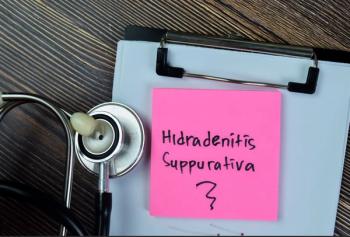
Two Cases of Episodic, Asymptomatic, Erythematous Eruptions
A 31-year-old white woman presents with an erythematous skin eruption of 2 weeks' duration that consists of papules on the cheeks and several disk-shaped papules and plaques on the back, posterior neck, and right upper anterior chest.
Figure 1
Case 1:
A 31-year-old white woman presents with an erythematous skin eruption of 2 weeks' duration that consists of papules on the cheeks and several disk-shaped papules and plaques on the back (Figure 1), posterior neck, and right upper anterior chest. The lesions have erupted episodically over the past 2 years. They initially appear on the back or face and then spread centrifugally to form rings.
The lesions are mildly pruritic. During a previous episode, treat- ment with an oral corticosteroid reduced the intensity of the pruritus, and the lesions faded after a few weeks.
The patient has no history of tick bites or identifiable provocative factors, and she does not know of any factors that exacerbate or ameliorate the eruption. She has untreated ro- sacea and eczema of the arms and the legs and a history of treated hypothyroidism.
The most prominent lesions are on the patient's back, where annular and arcuate lesions form a large confluent plaque with a dusky central clearing. No scaling or epidermal changes are evident. Skin biopsy of posterior truncal lesions reveals patchy perivascular and periadenexal lymphocytic inflammation; these findings are characteristic of Jessner lymphocytic infiltration of the skin.
The patient is treated with hydroxychloroquine, and the lesions resolve within a few days of treatment.
Figure 2
Case 2:
A 57-year-old whiteman presents with a skin eruption of a few days' duration that consists of large, annular, targetoid, erythematous plaques on the upper back and smaller plaques on both shoulders (Figure 2). The patient states that he noticed the lesions after he worked for a few hours in the sun; they have since increased in size and prominence. They do not itch and are not associated with constitutional symptoms. A few years earlier, he had a similar rash that resolved spontaneously. He is currently taking hydroxychloroquine for rheumatoid arthritis.
Skin biopsy of the lesions reveals perivascular and periadnexal chronic inflammation. Slight mucinous degeneration is present within the dermis. The findings are consistent with Jessner lymphocytic infiltration of the skin.
Treatment with a topical immunomodulator (tacrolimus) is started, and hydroxychloroquine is continued. After an initially equivocal therapeutic response, the lesions resolve within a few weeks.
JESSNER LYMPHOCYTIC INFILTRATION
This rare skin disorder was first described by Jessner and Kanof in 1953.1 Subsequently, several series of cases have been studied clinically and pathologically.2-4 Jessner lymphocytic infiltration of the skin is characterized by annular, erythematous papules and plaques. The face is the most common site of involvement, followed by the trunk. The condition affects adults, with a slight male predominance.4-6 The lesions typically wax and wane over an extended period; they may be associated with photosensitivity.2,3
The characteristic pathologic findings are dense, sleeve-like perivascular--and less commonly periadenexal or periappendageal--infiltrates of lymphocytes, with occasional mucin deposition in the dermis. According to the literature, these findings are supportive of, but not required for, the diagnosis. Several case studies revealed that patients who had these pathologic findings eventually received a diagnosis of Jessner lymphocytic infiltration of the skin.2,3 The disease is believed to be related to a localized lymphoproliferative disorder that involves both B-cell and T-cell lymphocytes.2,3
DIFFERENTIAL DIAGNOSIS
Jessner lymphocytic infiltration of the skin can be classified as a figurate or annular erythema, in which the pattern simulates infiltrated rings or arcs. The morphologic pattern is very distinctive and has a limited differential diagnosis:
- Tinea corporis lacks induration or elevation; it has an active discontinuous scaly border. Results of a potassium hydroxide examination are usually positive.
- Erythema annulare centrifugum, the most common figurate erythema, exhibits multiple expanding truncal rings, often with a trailing edge of scale and a dusky center.
- Erythema chronicum migrans, the characteristic rash of Lyme disease, presents with one or more expanding, oval, nonscaly plaques; the lesions may have a central induration or clearing that resembles a target. The rash may also exhibit vesiculation or crusting.
- Migratory arciform erythema probably represents a variant expression of Jessner lymphocytic infiltration, with prominent trunk involvement; it is not clearly a separate entity.3,6
Rare figurate erythemas include erythema gyratum, almost exclusively a sign of malignancy, and erythema marginatum, the evanescent rash of Still disease and rheumatic fever. Also consider sarcoidosis, tumid lupus, primary cutaneous B-cell lymphoma, and lymphocytoma cutis in the clinical differential diagnosis.
MANAGEMENT
Although hydroxychloroquine has been proposed as a treatment for Jessner lymphocytic infiltration of the skin, its effectiveness is uncertain. The patient in Case 1 responded to hydroxychloroquine; on the other hand, the condition developed in the patient in Case 2 while he was taking this drug. The spontaneous resolution of the condition makes it difficult to evaluate other therapies.2,3 Anecdotal reports indicate that anti-inflammatory and immunomodulator therapy may be effective.3,6
References:
REFERENCES:
1.
Jessner M, Kanof NB. Lymphocytic infiltration ofthe skin. Arch Dermatol. 1953;68:447-449.
2.
Helm KF, Muller SA. Benign lymphocytic infiltrateof the skin: correlation of clinical and pathologicfindings. Mayo Clin Proc. 1992;67:748-754.
3.
Poenitz N, Dippel E, Klemke CD, et al. Jessner’slymphocytic infiltration of the skin: a CD8
+
polyclonalreactive skin condition. Dermatology. 2003;207:276-284.
4.
Toonstra J, Wildschut A, Boer J, et al. Jessner’slymphocytic infiltration of the skin. A clinical studyof 100 patients. Arch Dermatol. 1989;125:1525-1530.
5.
Gottlieb B, Winkelmann RK. Lymphocytic infiltrationof the skin. Arch Dermatol. 1962;86:626-633.
6.
Braun-Falco O, Plewig G, Wolff HH, BurgdorfWHC. Pseudolymphoma. In: Braun-Falco O, PlewigG, Wolff HH, Burgdorf WHC, eds. Dermatology. 2nded. Berlin: Springer-Verlag; 2000:1603-1609.
Newsletter
Enhance your clinical practice with the Patient Care newsletter, offering the latest evidence-based guidelines, diagnostic insights, and treatment strategies for primary care physicians.
















































































































































































































































































